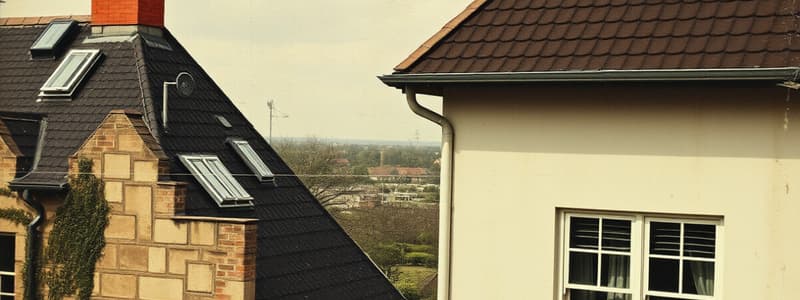Podcast
Questions and Answers
What is the primary reason for opening the roof when fire is detected in an attic or cockloft?
What is the primary reason for opening the roof when fire is detected in an attic or cockloft?
- To enhance the structural integrity of the building
- To limit the overall fire damage by reducing lateral spread of the fire (correct)
- To prevent smoke from entering the lower levels
- To allow for better visibility during an operation
Which of the following actions is NOT recommended when dealing with fire in an attic or cockloft?
Which of the following actions is NOT recommended when dealing with fire in an attic or cockloft?
- Calling additional resources if needed
- Coordinating ventilation with water application
- Making proper openings early
- Waiting for the fire to subside before opening the roof (correct)
How should the process of ventilation be managed when attacking a fire in an attic?
How should the process of ventilation be managed when attacking a fire in an attic?
- Ventilation must be carefully coordinated with the application of water (correct)
- Ventilation should be done independently of hose operations
- Ventilation should be delayed until all fire crews are in position
- Ventilation should be timed to maximize smoke removal only
What is a critical factor to consider when cutting openings in the roof?
What is a critical factor to consider when cutting openings in the roof?
What risk is associated with fire entering an attic or cockloft?
What risk is associated with fire entering an attic or cockloft?
Which roofing material poses the highest danger of fire spread due to its flammable nature?
Which roofing material poses the highest danger of fire spread due to its flammable nature?
What is a major challenge when attempting to open a roof made of plywood?
What is a major challenge when attempting to open a roof made of plywood?
What material is often used as a moisture barrier beneath roofing shingles?
What material is often used as a moisture barrier beneath roofing shingles?
During the venting of a hard roof such as slate or tile, what is the recommended approach to safely access the sheathing?
During the venting of a hard roof such as slate or tile, what is the recommended approach to safely access the sheathing?
What is a key hazard associated with removing slate or tile roofs when wet?
What is a key hazard associated with removing slate or tile roofs when wet?
What is the primary benefit of conducting proper roof ventilation during a fire in peaked roofs?
What is the primary benefit of conducting proper roof ventilation during a fire in peaked roofs?
Under what condition is horizontal window ventilation deemed sufficient instead of roof venting?
Under what condition is horizontal window ventilation deemed sufficient instead of roof venting?
What often causes unnecessary roof ventilation during firefighting operations?
What often causes unnecessary roof ventilation during firefighting operations?
Why is roof venting sometimes seen as traumatic for homeowners?
Why is roof venting sometimes seen as traumatic for homeowners?
What complicates operations during the initial stages of a fire when roof venting is conducted?
What complicates operations during the initial stages of a fire when roof venting is conducted?
In what situation may roof ventilation become a necessity during firefighting?
In what situation may roof ventilation become a necessity during firefighting?
Which technique is least effective for venting a first-floor kitchen fire in a two-story residence?
Which technique is least effective for venting a first-floor kitchen fire in a two-story residence?
Which factor makes attic areas particularly challenging for ventilation during a fire?
Which factor makes attic areas particularly challenging for ventilation during a fire?
What is the primary concern when making a roof opening for ventilation?
What is the primary concern when making a roof opening for ventilation?
When should personnel avoid committing to a roof for ventilation?
When should personnel avoid committing to a roof for ventilation?
What tool may be used to perform the cut on low-pitch roofs?
What tool may be used to perform the cut on low-pitch roofs?
Which of the following is a dangerous scenario on high-pitch roofs?
Which of the following is a dangerous scenario on high-pitch roofs?
What should personnel do once the cut for ventilation has been completed?
What should personnel do once the cut for ventilation has been completed?
Why is it recommended to bring a pick-head axe to the roof?
Why is it recommended to bring a pick-head axe to the roof?
Which aspect should NOT be ignored when planning how many personnel to send to the roof?
Which aspect should NOT be ignored when planning how many personnel to send to the roof?
What type of clothing should members performing roof ventilation wear?
What type of clothing should members performing roof ventilation wear?
What should be observed first to determine where to cut a peaked roof?
What should be observed first to determine where to cut a peaked roof?
Why is it important to place the cutting hole close to the peak of a roof?
Why is it important to place the cutting hole close to the peak of a roof?
What is the consequence of making a cutting hole on the upwind side of the peak?
What is the consequence of making a cutting hole on the upwind side of the peak?
How can hot spots be identified on a peaked roof?
How can hot spots be identified on a peaked roof?
What factor determines the side of the peak where the cutting hole should be made?
What factor determines the side of the peak where the cutting hole should be made?
What is the primary reason for cutting a strip along the peak of a roof for ventilation?
What is the primary reason for cutting a strip along the peak of a roof for ventilation?
What challenge do solar panels present to venting teams during a fire operation?
What challenge do solar panels present to venting teams during a fire operation?
When making a decision to vent during a fire, what factor must the venting team consider if solar panels are present?
When making a decision to vent during a fire, what factor must the venting team consider if solar panels are present?
How should firefighters approach working near roofs with photovoltaic panels?
How should firefighters approach working near roofs with photovoltaic panels?
What impact do electricity-generating photovoltaic panels have on a residential firefighting operation?
What impact do electricity-generating photovoltaic panels have on a residential firefighting operation?
What is a potential consequence of installing older-style satellite dishes on roofs without considering the load?
What is a potential consequence of installing older-style satellite dishes on roofs without considering the load?
What is an advantage of making a quick cut in a roof under challenging conditions?
What is an advantage of making a quick cut in a roof under challenging conditions?
Which of the following factors does not influence the size of the hole cut in a roof during firefighting?
Which of the following factors does not influence the size of the hole cut in a roof during firefighting?
In addition to the 4 ft x 4 ft hole, what alternative cutting method is suggested for difficult conditions?
In addition to the 4 ft x 4 ft hole, what alternative cutting method is suggested for difficult conditions?
Which scenario presents the greatest challenge when cutting a roof for ventilation?
Which scenario presents the greatest challenge when cutting a roof for ventilation?
What should be prioritized before cutting the roof during firefighting operations?
What should be prioritized before cutting the roof during firefighting operations?
Why are peaked roofs potentially more dangerous than flat roofs during a fire?
Why are peaked roofs potentially more dangerous than flat roofs during a fire?
What type of lumber is commonly used for roof joists in both older and newer homes?
What type of lumber is commonly used for roof joists in both older and newer homes?
Which factor contributes to the risk of falling through a roof while battling fires?
Which factor contributes to the risk of falling through a roof while battling fires?
What is a notable feature of tongue-and-groove boards compared to furring strips?
What is a notable feature of tongue-and-groove boards compared to furring strips?
Which structural design feature differentiates peaked roofs from flat roofs in terms of load capacity?
Which structural design feature differentiates peaked roofs from flat roofs in terms of load capacity?
What precaution should firefighters take when unsure about a roof's stability?
What precaution should firefighters take when unsure about a roof's stability?
What characteristic of lightweight wood in roof designs presents a danger during firefighting?
What characteristic of lightweight wood in roof designs presents a danger during firefighting?
What advantage does the quick cut method offer when venting a roof with plywood sheathing?
What advantage does the quick cut method offer when venting a roof with plywood sheathing?
What challenge may arise when using the hinge method for cutting a roof section?
What challenge may arise when using the hinge method for cutting a roof section?
Why might larger holes impede the effectiveness of roof ventilation during a fire?
Why might larger holes impede the effectiveness of roof ventilation during a fire?
What is a potential complication when performing a triangular cut from the basket of a platform?
What is a potential complication when performing a triangular cut from the basket of a platform?
When is it necessary to extend a cut or begin a new hole during roof venting?
When is it necessary to extend a cut or begin a new hole during roof venting?
What is the main advantage of traingular opening ventilation in firefighting?
What is the main advantage of traingular opening ventilation in firefighting?
What is one critical rule to follow when cutting for roof ventilation?
What is one critical rule to follow when cutting for roof ventilation?
In which scenario is it most crucial for firefighters to call for additional assistance?
In which scenario is it most crucial for firefighters to call for additional assistance?
What method should be used when manually venting a skylight that has not melted?
What method should be used when manually venting a skylight that has not melted?
What is a potential hazard faced while using a tool during skylight ventilation?
What is a potential hazard faced while using a tool during skylight ventilation?
What is the minimum recommended crew size for effectively managing an average house fire?
What is the minimum recommended crew size for effectively managing an average house fire?
What should firefighters avoid doing when cutting for roof ventilation?
What should firefighters avoid doing when cutting for roof ventilation?
Which sequence is essential when planning cuts for roof ventilation?
Which sequence is essential when planning cuts for roof ventilation?
Flashcards
Roof Ventilation Importance
Roof Ventilation Importance
Limits fire damage to peaked roofs by allowing hot gases to escape, improving firefighting effectiveness
Roof Ventilation Techniques
Roof Ventilation Techniques
Methods used for opening the roof to ventilate fires
Horizontal Window Ventilation
Horizontal Window Ventilation
Suitable for fires that haven't reached the roof directly; using horizontal windows to ventilate
Roof Ventilation in Attic Fires
Roof Ventilation in Attic Fires
Signup and view all the flashcards
Roof Access Challenges
Roof Access Challenges
Signup and view all the flashcards
Roof Joist Weakness
Roof Joist Weakness
Signup and view all the flashcards
Lightweight Roof Materials
Lightweight Roof Materials
Signup and view all the flashcards
Minimal Roof Sheathing
Minimal Roof Sheathing
Signup and view all the flashcards
Modern Roof Sheathing
Modern Roof Sheathing
Signup and view all the flashcards
Plywood Roof Sheathing
Plywood Roof Sheathing
Signup and view all the flashcards
Roof Cutting Safety
Roof Cutting Safety
Signup and view all the flashcards
Roof Cutting Tools
Roof Cutting Tools
Signup and view all the flashcards
Roof Cutting Techniques
Roof Cutting Techniques
Signup and view all the flashcards
Hot Spots & Cutting
Hot Spots & Cutting
Signup and view all the flashcards
Electrical Hazards
Electrical Hazards
Signup and view all the flashcards
Cut Size Recommendations
Cut Size Recommendations
Signup and view all the flashcards
Quick Cuts
Quick Cuts
Signup and view all the flashcards
Two-Person Operation
Two-Person Operation
Signup and view all the flashcards
Multiple Escape Routes
Multiple Escape Routes
Signup and view all the flashcards
Wind Direction Coordination
Wind Direction Coordination
Signup and view all the flashcards
Additional Resources
Additional Resources
Signup and view all the flashcards
Situational Awareness
Situational Awareness
Signup and view all the flashcards
Firefighting Operations
Firefighting Operations
Signup and view all the flashcards
Hoseline Operations
Hoseline Operations
Signup and view all the flashcards
Cutting Coordination
Cutting Coordination
Signup and view all the flashcards
Study Notes
Roof Ventilation Overview
- Ventilation is critical for limiting fire damage in peaked roofs, primarily found in private dwellings.
- Proper roof ventilation reduces lateral fire spread and aids firefighting efficiency by allowing hot gases to escape.
- Essential firefighting operations include search, rescue, attack, salvage, and overhaul, which benefit from adequate ventilation conditions.
Roof Ventilation Techniques
- Roof venting must be coordinated with hoseline operations; cutting should not occur until hoselines are active.
- Horizontal window ventilation is often sufficient for fires not extending directly into the roof area.
- In advanced attic or cockloft fires, roof ventilation becomes necessary, as these areas typically lack windows for effective venting.
Hazards and Structural Considerations
- The pitch of peaked roofs poses challenges for access and safety during firefighting operations.
- Roof joists in peaked structures may be weaker than in flat roofs, commonly consisting of 2x6 lumber spaced 16-24 inches apart.
- Lightweight materials such as 2x4s and gusset-plate trusses significantly increase risk when operating on roofs.
Roof Sheathing Types
- Older homes often use minimal roof sheathing, typically 1x2 furring strips, posing risks of falling through the roof.
- Newer homes may have 1x6 tongue-and-groove boards, which improve support but also complicate opening operations.
- Plywood sheathing requires more effort to ventilate due to its resistance to cutting and numerous nails securing it.
Making Roof Cuts
- Safety is paramount; assess roof stability before committing personnel to ventilation tasks.
- Full protective gear, including SCBA, is mandatory for firefighters conducting roof ventilation.
- Preferred cutting tools include power saws for low-pitch roofs, while higher pitches may necessitate the use of axes due to safety concerns.
Guidelines for Cutting Peaked Roofs
- Cut near the roof peak to maximize hot gas release; assess wind direction for optimal vent placement.
- Hot spots, indicated by bubbling tar or melting snow, guide cut location.
- Ensure any venting under electrical sources, especially solar panels, avoids additional hazards.
Effective Ventilation Strategies
- A 4x4 ft cut is recommended for effective heat release, though adapting to conditions may be necessary.
- Quick cuts that span fewer joists allow for easier removal and expedited ventilation.
- The necessity of a two-person operation for safety and efficiency is emphasized in roof ventilation tasks.
Operational Safety and Coordination
- Always have two escape routes and maintain situational awareness among crew members regarding cut locations.
- Coordinate cuts with wind direction to prevent heat blowback toward hoseline operations.
- During fires in challenging areas, call for additional resources and maintain a strong and experienced crew to handle complex situations.
Studying That Suits You
Use AI to generate personalized quizzes and flashcards to suit your learning preferences.



